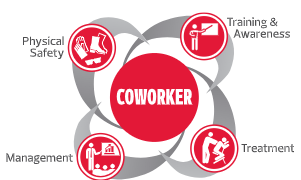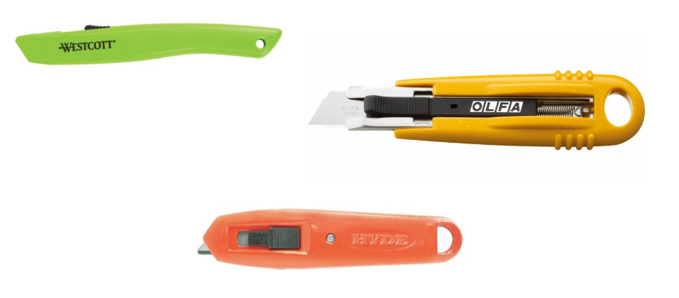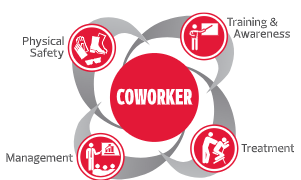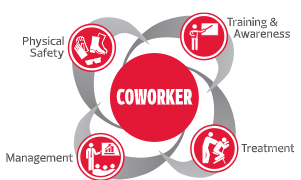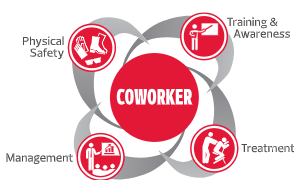Information
-
Warehouse Name
-
Address
-
How large is the warehouse? (describe, sq ft, made up of # buildings etc.)
-
How many entrances into the warehouse are there?
-
About how many coworkers work at this location?
-
Conducted on
-
Prepared by
References
-
Risk Matrix Reference
-
Risk - An estimate of the probability of a hazard-related incident or exposure occurring and the severity of harm or damage that could result. (ANSI/ASSE Z590.3-2011)
Level of Risk - Magnitude of a risk or combination of risks, expressed in terms of the combination of consequences and their likelihood. (ISO Guide 73/ANSI/ASSE Z690.1- 2011)
Likelihood - Chance of something happening. (ISO Guide 73/ANSI/ASSE Z690.1- 2011)
Risk Matrix - Tool for ranking and displaying risks by defining ranges for consequence and likelihood. (ISO Guide 73/ANSI/ASSE Z690.1-2011)
Hierarchy of Controls - A systematic approach to avoiding, eliminating, controlling, and reducing risks, considering steps in a ranked and sequential order, beginning with avoidance -
Hierarchy of Controls Reference
General Safety
General Safety
-
Dress code being followed (No open toed shoes, no rings, no watches, necklaces tucked in, etc.)
-
Adequate periodic rest breaks to avoid fatigue levels that could result in greater risk of accidents and reduced quality of work.
-
Hearing protection being worn where required.
Housekeeping
Housekeeping
-
Areas are free of tripping hazards.
-
Aisles free from obstructions such as skids, equipment, shelves.
-
Floors are clean and free from slippery substances such as water, oil, etc.
-
Scrap metal, pallet banding straps, plastic wrap, wood, box cutter blades, etc. deposited in the proper containers.
Walking Working Surfaces/Fall Protection
FALLS OR FALLING OBJECTS
-
All staircases secure and fitted with suitable handrails.
-
Exposed or open loading dock doors and other areas that employees could fall 4 feet or more or walk off are chained off, roped off or otherwise blocked.
-
Ladders, platforms, step stools and other equipment for working at heights in good repair and suitable for the task.
-
Materials and objects adequately stored or stacked to prevent them from falling and causing injury.
-
Fall protection equipment (harnesses, lanyards, etc.) inspected by a competent person once a year.
-
Records kept?
Material Handling and Equipment
Material Handling Equipment
-
Are all containers, skids, pallets, materials, and equipment arranged neatly and orderly in assigned areas.
-
Only certified personnel operating fork lifts
-
How are certified drivers tracked? (infolink, badge, etc.)
-
Approved Safety cutters
-
Only approved safety knives are being used.
-
Pallets properly banded or secured for shipment.
-
Forklifts and pallet jacks in good condition.
-
Material stored so it does not block sprinkler heads, alarm systems, electrical panels, or access to fire extinguishers? (A minimum clearance of 3 feet )
-
There is adequate clearance from overhead light fixtures when placing material overhead.
-
Pallet jacks are stored in a manner that would minimize the possibility of tripping (under load and handle turned sideways).
-
Nameplates and markings are in place and maintained in a legible condition.
-
Battery charging is conducted only in designated areas.
-
Precautions are taken to prevent smoking, open flames, sparks or electric arcs in battery charging areas (signage).
- Safe
- At Risk
- N/A
-
Refresher training and evaluation is conducted whenever an operator has been observed operating the vehicle in an unsafe manner or has been involved in an accident or a near-miss incident.
-
Evaluations of each operator’s performance are conducted at least once every three years.
-
Load engaging means are fully lowered, with controls neutralized, power shut off and brakes set when a forklift is left unattended.
-
There is sufficient headroom for the forklift and operator under overhead installations, lights, pipes, sprinkler systems, etc.
-
Operators observe all traffic regulations, including authorized speed limits.
-
Dock plates are properly secured when loading or unloading.
LIFTING AND HANDLING
-
Mechanical equipment, such as conveyors, fork lifts, lifts, etc. are used to avoid manual handling.
-
Coworkers are properly trained in lifting and other manual handling techniques.
Electrical Safety
-
No electrical cords with frayed wired, loose ends, broken insulation, etc.
-
Fans have protective covering with no damage.
-
Outlets are not damaged and do not show signs of burning.
-
The facility has lockout/tagout procedures.
Environmental
Air Quality
-
Temperature, ventilation, and lighting are adequate.
-
Ventilation systems regularly inspected, tested and maintained.
-
Air inlets and exhaust free of accumulation of dust and mold.
Waste
-
Universal Waste locations set up and maintained (accurate signage).
-
Recycles: Bottles/Cans, Paper, Batteries, Toner.
-
Who is responsible for the Universal Waste in the building:
-
Coworkers know what to do with old/used batteries and equipment.
Hazard Communication
Hazard Communication Safety
-
All hazardous materials containers are properly labeled, indicating the chemical’s identity, the manufacturer’s name and address, and appropriate hazard warnings.
-
There is an updated list of hazardous chemicals.
-
The facility has a written program that covers hazard determination, including Safety Data Sheets (SDSs), labeling and training.
-
There is a system to check that each incoming chemical is accompanied by a SDS.
-
All employees are trained in the requirements of the hazard communication standard, the chemical hazards to which they are exposed, how to read and understand a SDS and chemical labels, and on what precautions to take to prevent exposure.
-
All employee training is documented.
-
Employees use proper personal protective equipment when handling chemicals.
-
All chemicals are stored according to the manufacturer’s recommendations and local or national fire codes.
Fire Safety
Fire Safety
-
Fire extinguishers are all accounted for and have been inspected as per NFPA 10.
-
Check the inspection Tag.
-
Exits, aisles, evacuation routes, and fire alarm pull stations are unblocked.
-
Pull stations are properly housed/ in tact.
-
All exit signs and evacuation lights are fully operational.
-
Debris, discarded packing materials, trash, and flammable items are in proper waste bins (nothing is accumulating where it shouldn’t).
-
Extension cords and electrical equipment are being used properly; no extension cords are being used long-term or connected to each other.
-
Nothing is hanging from fire sprinkler/suppression systems lines, heads, nozzles.
-
Fire pump riser rooms are empty – nothing should be stored in these.
-
Flammable/combustible liquids are in safety cabinets and stored per OSHA1926, NFPA30, and your local Authorities Having Jurisdiction (AHJ) guidelines.
Emergency Management & Response
-
Designated Severe Weather Shelter Areas exist (Away from windows, external walls, clearly marked).
-
There are designated Emergency Response Team (ERT) members.
-
ERT up to date and accurate with who is on site.
-
All emergency exits visible and properly marked.
-
Coworkers know and are trained on the evacuation procedures.
-
Emergency Maps posted and up to date.
-
Designated Evacuation Assembly area(s) visible and located at safe distance(s).
-
Emergency contact list up to date.
-
Date of the last time the facility had a drill:
First Aid
-
First aid kit(s) available and in good condition.
-
Total number of First Aid Kits on site:
-
Who checks the First Aid Kit(s):
-
How often is the First Aid Kit checked:
-
Sufficient supplies<br>*See OSHA Link below for First Aid Kit Requirements*
-
https://www.osha.gov/laws-regs/regulations/standardnumber/1910/1910.266AppA
-
First aid kits don't contain prescription or over-the-counter medications such as aspirin, Ibuprofen, decongestants, sinus relief, etc. (due to not being first aid/ liability risk there should not be any of these in the first aid kit)
-
No defective item(s).
-
Nothing out-of-date/expired.
AEDs
-
Total number of AEDs on site:
-
Make/Model of AEDs utilized:
-
AEDs inspected by:
-
AEDs inspected monthly and in good condition (pads not expired, no missing supplies)
Coworker Awareness (Ask 3 Coworkers)
-
Provide Coworker with answer if they do not know.
-
Coworker 1
-
Do you know what the ERT is?
-
Do you know where an AED is located?
-
Do you know where a First Aid Kit is located?
-
Do you know what to do in an emergency? (Fire, tornado)
-
Person 1 signature
-
Coworker 2
-
Do you know what the ERT is?
-
Do you know where an AED is located?
-
Do you know where the first Aid Kit is located?
-
Do you know what to do in an emergency? (Fire, tornado)
-
Person 2 signature
-
Coworker 3
-
Do you know what the ERT is?
-
Do you know where an AED is located?
-
Do you know where the First Aid Kit is located?
-
Do you know what to do in an emergency? (Fire, tornado)
-
Person 3 signature
Trailer Yard
-
Yard is clear of major obstructions and has clear passageways for vehicle traffic.
-
Yard is free of debris (Pallets, trash, etc.)
-
Trailer yard access is restricted.
Parking Lot
-
Parking lot is clear of debris.
-
Sidewalks, ramps and walking surfaces in good repair.
-
Mirrors or STOP signs posted at blind spots.
-
Directional signs posted and are legible.
-
Lot paved, lines & directional arrows visible.
-
Vegetation is trimmed away from walkways & entrances.
-
No tripping hazards, Curbs, Holes, Debris.
-
Designated pedestrian walkways.
-
Designated handicapped parking spots (ADA compliant: 8 foot wide with 5 foot access aisle between parking spaces? Signage?)
- Safe
- At Risk
- N/A
-
Are ramp slopes to entrance provided.
-
Lot bumpers secured. Easily identified.
Required Postings
-
State, Federal law and OSHA “Job Safety and Health - It’s the Law” Poster posted in easily accessible location where coworkers will see them.
-
OSHA 300A (injury and illness summary data) Log signed and posted from 02/01 until 04/01 each year, in a common area where any coworker can easily see it.
Visitor Safety/Security
-
Is there building security on site?
-
What is the name of the security company?
-
Metal detectors working as intended.
-
Visitors Safety Guide Brochure/ Visitor Guidance available at entrance and current/up to date.
-
There are cameras that cover this warehouse.
-
Ask GSOC if all cameras are operational (add note of what cameras are not)
Completion
-
Any other observations or recommendations
-
Full Name and Signature of the Inspector
